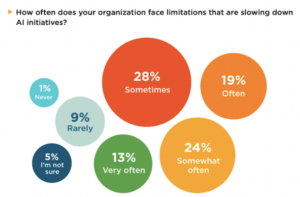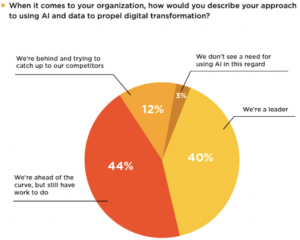Altair has released results from an international survey revealing high rates of adoption and implementation of data and AI strategies. The survey also found that projects stall due to three types of friction: organizational, technological, and financial.
“Organizations today recognize the imperative of using their data as a strategic asset to create competitive advantages,” said James R. Scapa, founder and CEO of Altair. “But friction points clearly exist around people, technology, and investment preventing organizations from gaining the data-driven insights needed to deliver results.”
The survey revealed that unfilled data science roles are causing organizational friction, as 75% of respondents reported struggling to find enough data science talent. Another 35% disclosed that AI literacy is low among the majority of their workforce, and 58% said the shortage of talent and the time needed to upskill current employees is the most pressing problem in their AI adoption strategy.
As a result, Altair found that many organizations struggle to complete data science projects. Survey responses revealed that 33% of respondents reported more than half of their data science projects never made it to production in the last two years, and 55% said more than a third of their data science projects stalled during the same time. This seems like a common problem, as 67% of those surveyed revealed that more than a quarter of projects never made it to production.
Technical limitations are another source of friction that can hamper data and AI initiatives. Respondents reported contending with sluggish data processing and decision making, as well as data quality issues. Nearly two-thirds (63%) of those surveyed said their organization tends to make working with AI-driven data tools more complicated than necessary. Additionally, 33% cited legacy systems as a hindrance in developing advanced AI and ML initiatives.
Financial friction is also a factor in stalled AI projects, and 25% of those surveyed mentioned financial constraints as negatively affecting AI initiatives within their organization. Another 28% said leadership is too focused on the strategies’ upfront costs to understand how investing in AI ML would benefit their organization, while 33% said the high cost of implementation (whether real or perceived) is an organizational shortfall.
The survey also explored AI project failure rates and found that 42% of respondents admitted to experiencing AI failure within the past two years, and among those respondents, the average failure rate was 36% at their organization. Despite high project failure rates, use of AI persists across industries and geographic regions, Altair says. Though one in four respondents said that more than 50% of AI projects fail, organizations continue to use AI because they believe there is still an opportunity to level up capabilities or services in the long run (78%) and its minor successes have shown potential for long-term breakthroughs (54%).
Altair concludes its report with the acknowledgment that friction in and around organizational data and AI strategies is incredibly common within organizations worldwide, regardless of industry. Organizations are taking steps to overcome these challenges but are still facing complex roadblocks.
“To achieve what we call ‘Frictionless AI,’ businesses must make the shift to self-service data analytics tools that empower non-technical users to work easily and cost-effectively across complex technology systems and avoid the friction inhibiting them from moving forward,” said Scapa.
Read the full report at this link.
Related Items:
Altair Gives Legacy SAS Code a New Place to Run
Altair Launches Unified Environment for HPC, Analytics, CAE, and AI
Altair Shows Off Converged Analytics Lineup
The post Altair Survey Unpacks the Friction Surrounding AI and Data Projects appeared first on Datanami.


0 Commentaires